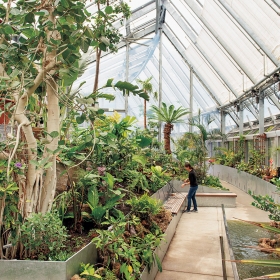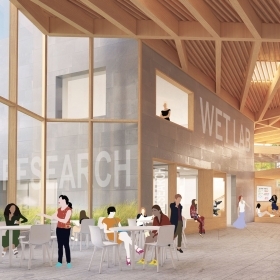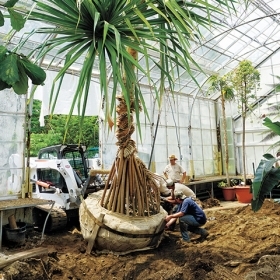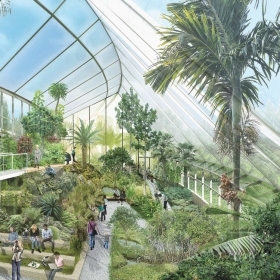The new global flora collection celebrates plant diversity
The Global Flora Conservatory at the Margaret C. Ferguson Greenhouses, it steel frame clad in high-tech plastic, rides the curve of the ridge outside the Science Center and soars to 40 feet at its southwest end. The new structure is breathtaking inside and out.

A flourishing banyan tree (foreground) puts down roots in the wet biome.
In summer and early fall, the translucent walls of the Global Flora Conservatory at the Margaret C. Ferguson Greenhouses are obscured by trees, so a casual stroller on campus might miss the new structure entirely. But it’s well worth a detour up Science Hill. Up close, the steel frame clad in high-tech plastic is breathtaking, riding the curve of the ridge outside the Science Center and soaring to 40 feet at its southwest end. For visitors accustomed to the Victorian-style glasshouses that had held Wellesley’s botanical specimen plants for so many decades, the new space is nothing less than mind-boggling.
This fall, a short punch list of items—including installation of a mural by Associate Professor of Art David Teng Olson and students in his Digital Imaging class in the curved hallway, known as “the link,” through which visitors will enter—remained to be completed. But plants were settling into their beds and putting out new growth, the iconic Durant camellia, estimated to be 150 years old, was thriving in its new circular pavilion, and staff members and students were tucking a few more plants into beds.
“The whole idea is celebrating diversity in plant form,” says Kristina Niovi Jones, director of the Wellesley College Botanic Gardens, who has shepherded the Global Flora project for more than a decade. Plants wear their history in their form—both the evolutionary record of the species and the growth history of the individual in its particular environment—she explains.

Kristina Niovi Jones, director of the Wellesley College Botanic Gardens, works with students.
A Place to Grow
Entering Global Flora from the link is akin to stepping into a desert environment. The dry biome section of the structure is arid and warm; cacti in an array of shapes and sizes line beds set off by ledges of stone. A variety of epiphytes and ferns suspended on a wall dangle their graceful tendrils. Slatted benches set into the low stone walls around the beds invite visitors to sit—and also serve a practical purpose, as their seats can be lifted for access to water and hoses in one section and connections for the sophisticated electronics monitoring the air and soil in the other. High overhead, fans whir and sensors that monitor temperature and humidity hang from the ceiling.
A few steps bring a visitor into the wet biome, where a recently installed towering tree fern has already sent new growth—enormous, curving fiddleheads—reaching toward the ceiling. “That one came from UConn, and it actually had been hitting the roof of their greenhouse,” says Jones. “Now it’s as if it’s saying, ‘Oh, headspace!’”
Referring to plants as sentient beings is habitual with Global Flora staff members, who keep a close eye on every living thing in the collection, from Aloinopsis malherbei (giant jewel plant) to Xerosicyos danguyi (silver dollar plant).
Many of the plants in Global Flora come from Wellesley’s original collection, which during greenhouse demolition and construction had been farmed out to greenhouses at the Massachusetts Horticultural Society and the Hunnewell estate down the road, as well as housed in small temporary structures set up on campus for the duration. But there are many new plants, as well—including that happy tree fern. Some of the new specimens were gathered during a collecting trip that Jones and Rob Nicholson, botanical collections manager, took last summer, beginning in Florida and stopping at botanical gardens, universities, and nurseries on the way back north.
“We had a minivan for the first couple of days, and then when we were starting to accumulate enough plants, we got a big Penske truck,” Nicholson says. “And Kristina’s a great truck driver.”
‘[Global Flora] will just floor people with diversity of form and texture and color. It’s a cathedral of sorts, a temple of biodiversity.’
Nicholson previously managed the Lyman Conservatory of the Botanic Garden of Smith College. He laughs as he talks about the trip, saying he was calling in favors from fellow botanists all the way up the coast as they gathered the plants, many of them donated. “Botanic gardens have always swapped plants with each other,” he says. “It’s a smart thing to network with other gardens and be generous, because it comes back to you. When I was at Smith, I was giving away thousands of plants. We always had surplus plants from collecting trips or whatever, so I had a really well developed network of other conservatory managers and curators who owed me.”
Asked if he has favorites in the collection, Nicholson demurs: “If you ask a botanist, What’s your top 10 list, they just fall apart. I can’t give you 10.” But he admits to a couple of favorites, including Strongylodon macrobotrys, the jade vine. “It has turquoise flowers. It’s in the legume family. I just put a wire in place for it to climb. It’s already wanting to go up, up, up. It’s spectacular when it flowers.”
Nicholson says it will be five to 10 years before the plantings truly fill in. When they do, Global Flora “will just floor people with diversity of form and texture and color,” he says. “It’s a cathedral of sorts, a temple of biodiversity.”
Reimagining the Greenhouse
A typical greenhouse is an energy- and water-intensive building. But for this project, the College and Boston-based Kennedy & Violich Architecture worked to reimagine the structure as a sustainable, net-zero energy building.
“We’re going for Living Building Challenge certification,” says Cathy Summa ’83, associate provost and director of the Science Center. Global Flora must be open a year to collect data to be eligible for the challenge, which is administered by the nonprofit International Living Future Institute. It recognizes buildings that connect occupants to light, air, food, nature, and community; are self-sufficient and remain within the resource limits of their site; and create a positive impact on the human and natural systems that interact with them.
One award for the building is already in hand. This spring, the project won bronze in the LafargeHolcim Design Awards competition, among more than 5,000 entrants. The awards program is considered the most significant international competition for sustainable design.
The secret is the structure’s ETFE cladding. A thick, translucent plastic, ETFE (Ethylene tetrafluoroethylene) is lighter and more flexible than glass. Using it requires much less structural support, which allowed the architects to add more height and volume than the previous greenhouses had.
“Nobody anywhere has built a greenhouse of this shape and material,” says Jones. “There’s about half as much steel as there would have been if this were glass.”
The exterior consists of two-layer pillows of ETFE. Each pillow is connected to a compressed air system that blows air in or lets air out, constantly measuring the pressure in that pillow. As atmospheric pressure fluctuates, the pillows respond.

A living link to the College’s history, the Durant camellia, donated by Wellesley founder Henry Durant in the 1870s, is thriving in its new pavilion.
“The pillows make a huge difference in insulating the building,” says Jones. “Single-layer ETFE doesn’t insulate much, but the large amount of air between the layers is a great buffer for temperature differences. Last winter, the inner layer of ETFE barely felt cold.”
“It can withstand the New England snow load,” adds Summa. “We had some good snow on it after [the ETFE] was installed. We originally had a gutter on the building, but we had to take it off, because the snow just slid right off and into the gutter and pulled it off. So we redesigned.”
Consideration of the plants’ basic needs—water and light—was central to planning the design. The south-facing conservatory is replete with light. A computer-controlled interior shade system mitigates summer glare. Recycled rainwater from the roof of the structure and from the Science Center roof, captured in two massive underground cisterns, is drawn up, filtered, and used for hand-watering the plants as needed. Data from sensors, as well as old-fashioned observation by staff, determine which plants need what, and when.
“This building is built as a research platform, so that it is fully instrumented,” says Summa. “We’re monitoring the water and how we water. We’re monitoring the air temperature, humidity, etc. We’re monitoring the nutrients in the soil. We’re monitoring everything we possibly can.”
The new structure provides a place where growing season lasts year-round, Jones says, making it ideal for teaching. “The opportunity to study plants, microbes, fish, predator-prey interactions, and things like that in a bubble in New England is really cool. We’ll have a lot more ecology going on in here, studying the relationships between things. Because the plants are out of their pots and in the ground, they will be interacting underground, and we’re trying to visualize more about what’s happening underground with the sensors. We’re interested in things like how nutrients are moving through the system, how the water’s moving. It’s still a museum of plants, a really amazing collection, but they’re also part of a community that we hope will interact with each other.”
Jennifer Yang ’12, a postdoctoral botany fellow who also works with the College’s Paulson Ecology of Place Initiative, is deeply engaged with that observation via the sensor network she installed and is managing. The Exploring Plants in Context (EPIC) platform uses sensors in the soil to continuously gather data about water content, pH, salinity, and more. The data will be available for analysis in interdisciplinary science courses.
“The hope is that we can compare processes from the wet biome versus the dry biome, which are very different adaptations, and understand more about the soil chemistry,” she says.
Yang was in Global Flora on “day zero,” when the soil, rocks and boulders, and large trees were moved in. “We were so worried that the trees wouldn’t like the new place. After a week or two, they had all sprouted fresh green growth. That was the OK from the plants.”
[supporting-images]
If You Build It, They Will Come
Wellesley College trustee Mary White ’79, a physician based in New York, loves greenhouses. “For me, they are a silent refuge of living things. Their stillness has always appealed to me.”
White, who majored in molecular biology and is the major funder of Global Flora, became intrigued by the project when Kristina Jones explained its emphasis on plant form. “I have a terrible sense of smell,” White says, laughing. “I don’t get it when someone says, ‘That flower smells so great.’ When Kristina started talking form, about the visual aspect, that clicked with me. I thought, ‘This is the project I want to support.’ She has an interesting way of thinking about the plants that really animates the place. The fact that every single plant is different and has its own individual form and appearance makes you come up with three or four questions about how it got that way. It’s very stimulating.’’
White, who says she provided support for the project “in honor of all students of nature,” predicts that Global Flora will become a new gathering place both for scientific study and for aesthetic enjoyment. “I think eventually it will be like the MFA [Museum of Fine Arts, Boston], a place for research and contemplation, and people will come again and again. They’re going to have to take reservations.”
Visitors are sure to pause in the circular pavilion housing the now-thriving Durant camellia, a contemplative space named in honor of donors Nan Walsh Schow ’54 and her husband, Howard. The space features a beautiful curving bench fashioned from the wood of a Japanese cedar that grew in the courtyard outside the old glasshouses, but had to come down during construction.
Although Global Flora will remain closed to the general public until the completion of the Science Center renovation in two years, the space opened during limited hours to members of the College community this fall. The community was welcomed in on Aug. 26, and the traditional first-year plant giveaway took place as usual early in September.
Jones says she was happy to start teaching her fall seminar, Topics in Biodiversity, in the space. And, she adds, “Everyone who teaches Bio 111, the organismal bio, which is a pretty significant fraction of the bio department, will be in here. [Associate Professor of Environmental Studies] Alden Griffith will definitely be bringing students and maybe even doing experiments. And the chemists are interested in the ETFE.”
But Jones emphasizes that Global Flora is for everyone on campus, not just scientists. This upholds the wish of legendary Wellesley professor of botany Margaret C. Ferguson, who in 1925 wrote, “It is our purpose that the department shall stand, primarily, in the future as in the past, for the dignity and educational value of its scientific work. At the same time we shall not fail to emphasize the humanistic aspects of our subject; and we shall endeavor to form a center that shall be of interest to all.”
“I think Margaret Ferguson would be really psyched [to see Global Flora]. She was all about making sure that everyone understood how cool plants are,” says Jones. “I think people are going to come here and hang out. I hope we have a lot of art students here interpreting it. It’s beautiful. And people love things that are beautiful.”
Catherine O’Neill Grace is a senior editor for this magazine. If she’s not in the office, you will be able to find her on a bench in Global Flora, contemplating plant form.


